Critical Appraisal of Non-Communicable Disease Aetiology Report
VerifiedAdded on 2023/04/20
|8
|1512
|97
Report
AI Summary
This report critically appraises a study examining the aetiology of non-communicable diseases, specifically focusing on the relationship between childhood obesity, adolescent health, and cardiovascular risk in adulthood. The report summarizes the study's methodology, which utilized cohort data to investigate the impact of obesity during different life stages on cardiovascular outcomes. It evaluates the evidence supporting the association between obesity and cardiovascular risk, considering the sensitive period and accumulation of risk models. The report also discusses the study's limitations, including reliance on self-reported data, the use of BMI measurements at single time points, and the generalizability of findings to diverse populations. It highlights the importance of considering ethnic variations and the potential impact of evolving obesity trends on long-term health outcomes. The analysis underscores the complexities of NCD aetiology and the need for further research with robust methodologies.

Critical appraisal of non-
communicable disease aetilogy
communicable disease aetilogy
Paraphrase This Document
Need a fresh take? Get an instant paraphrase of this document with our AI Paraphraser
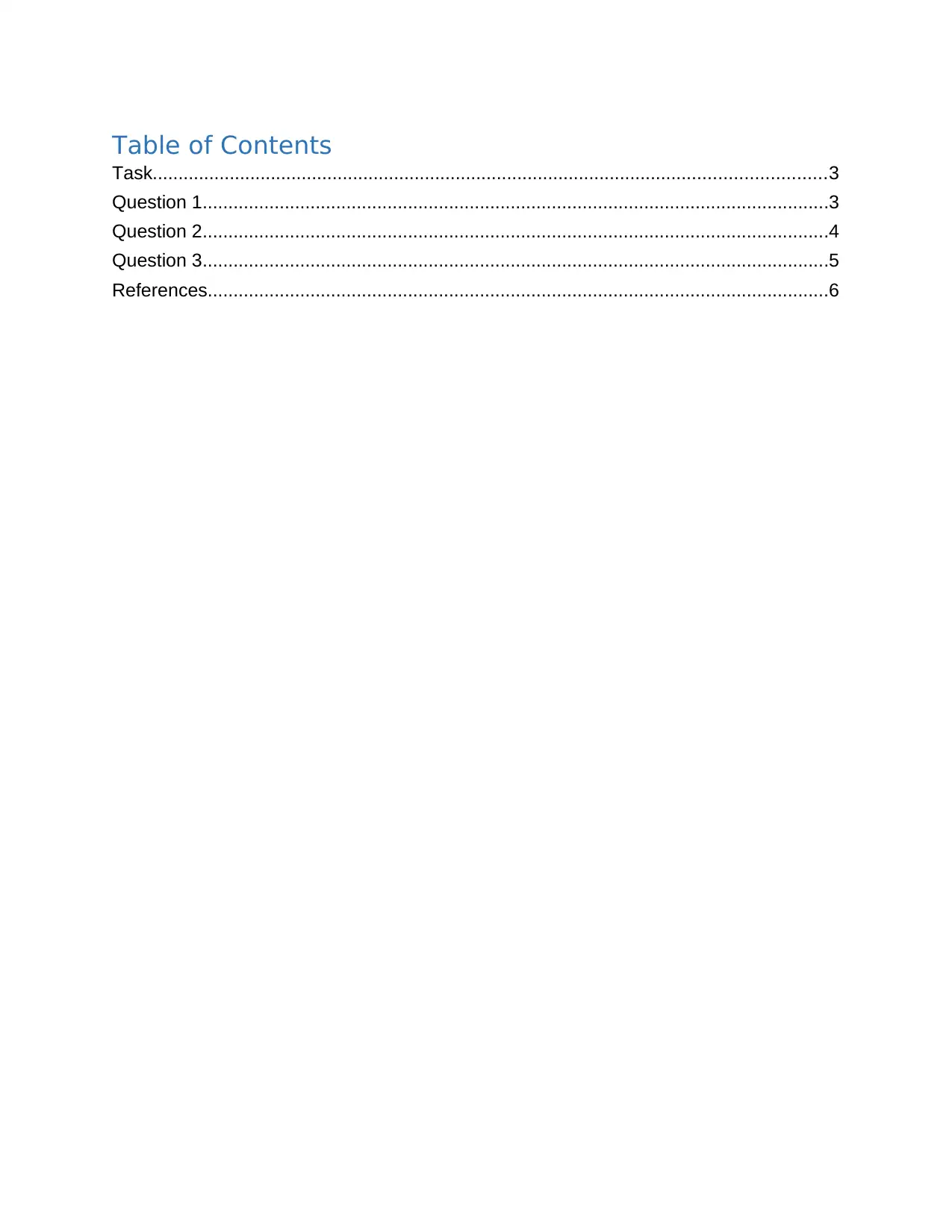
Table of Contents
Task...................................................................................................................................3
Question 1..........................................................................................................................3
Question 2..........................................................................................................................4
Question 3..........................................................................................................................5
References.........................................................................................................................6
Task...................................................................................................................................3
Question 1..........................................................................................................................3
Question 2..........................................................................................................................4
Question 3..........................................................................................................................5
References.........................................................................................................................6
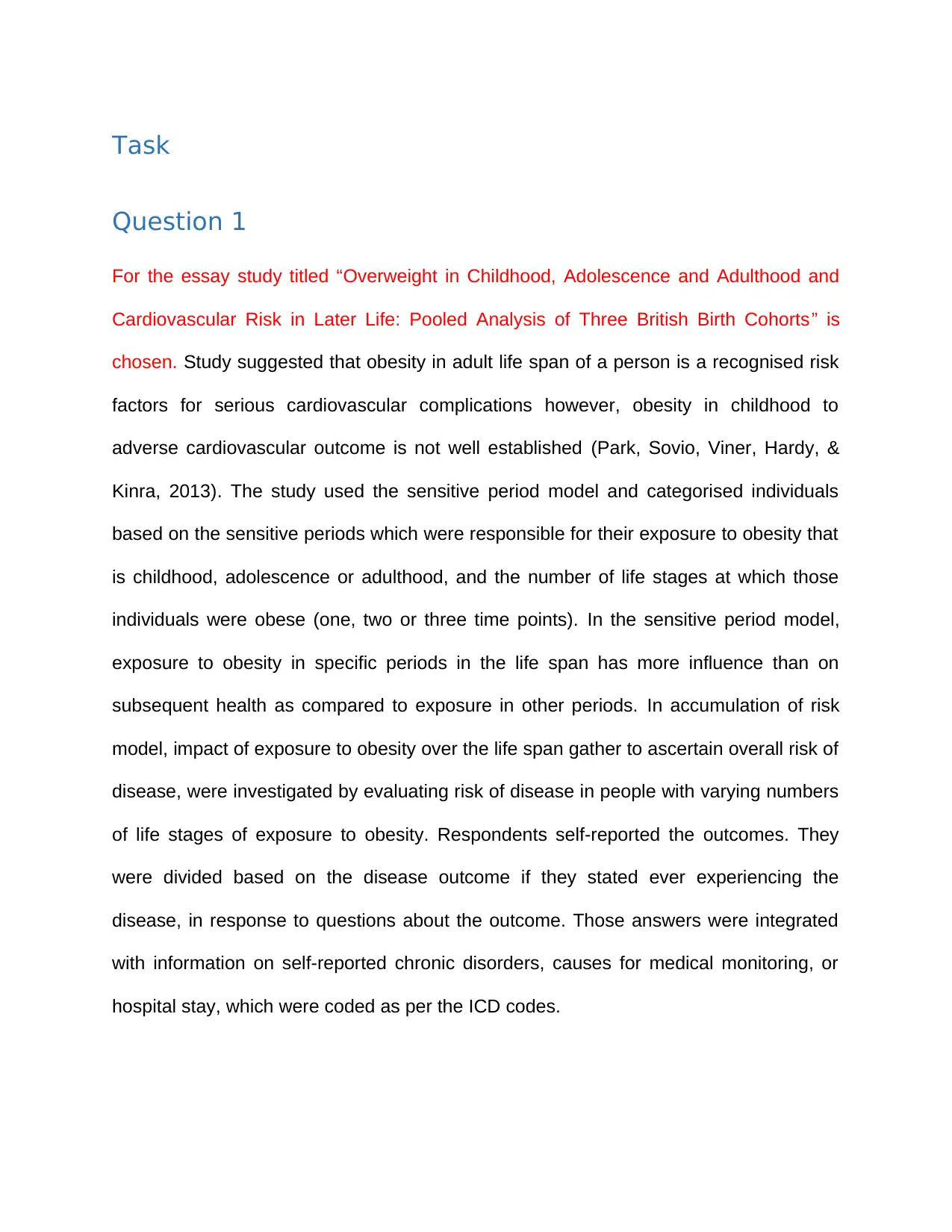
Task
Question 1
For the essay study titled “Overweight in Childhood, Adolescence and Adulthood and
Cardiovascular Risk in Later Life: Pooled Analysis of Three British Birth Cohorts” is
chosen. Study suggested that obesity in adult life span of a person is a recognised risk
factors for serious cardiovascular complications however, obesity in childhood to
adverse cardiovascular outcome is not well established (Park, Sovio, Viner, Hardy, &
Kinra, 2013). The study used the sensitive period model and categorised individuals
based on the sensitive periods which were responsible for their exposure to obesity that
is childhood, adolescence or adulthood, and the number of life stages at which those
individuals were obese (one, two or three time points). In the sensitive period model,
exposure to obesity in specific periods in the life span has more influence than on
subsequent health as compared to exposure in other periods. In accumulation of risk
model, impact of exposure to obesity over the life span gather to ascertain overall risk of
disease, were investigated by evaluating risk of disease in people with varying numbers
of life stages of exposure to obesity. Respondents self-reported the outcomes. They
were divided based on the disease outcome if they stated ever experiencing the
disease, in response to questions about the outcome. Those answers were integrated
with information on self-reported chronic disorders, causes for medical monitoring, or
hospital stay, which were coded as per the ICD codes.
Question 1
For the essay study titled “Overweight in Childhood, Adolescence and Adulthood and
Cardiovascular Risk in Later Life: Pooled Analysis of Three British Birth Cohorts” is
chosen. Study suggested that obesity in adult life span of a person is a recognised risk
factors for serious cardiovascular complications however, obesity in childhood to
adverse cardiovascular outcome is not well established (Park, Sovio, Viner, Hardy, &
Kinra, 2013). The study used the sensitive period model and categorised individuals
based on the sensitive periods which were responsible for their exposure to obesity that
is childhood, adolescence or adulthood, and the number of life stages at which those
individuals were obese (one, two or three time points). In the sensitive period model,
exposure to obesity in specific periods in the life span has more influence than on
subsequent health as compared to exposure in other periods. In accumulation of risk
model, impact of exposure to obesity over the life span gather to ascertain overall risk of
disease, were investigated by evaluating risk of disease in people with varying numbers
of life stages of exposure to obesity. Respondents self-reported the outcomes. They
were divided based on the disease outcome if they stated ever experiencing the
disease, in response to questions about the outcome. Those answers were integrated
with information on self-reported chronic disorders, causes for medical monitoring, or
hospital stay, which were coded as per the ICD codes.
⊘ This is a preview!⊘
Do you want full access?
Subscribe today to unlock all pages.

Trusted by 1+ million students worldwide
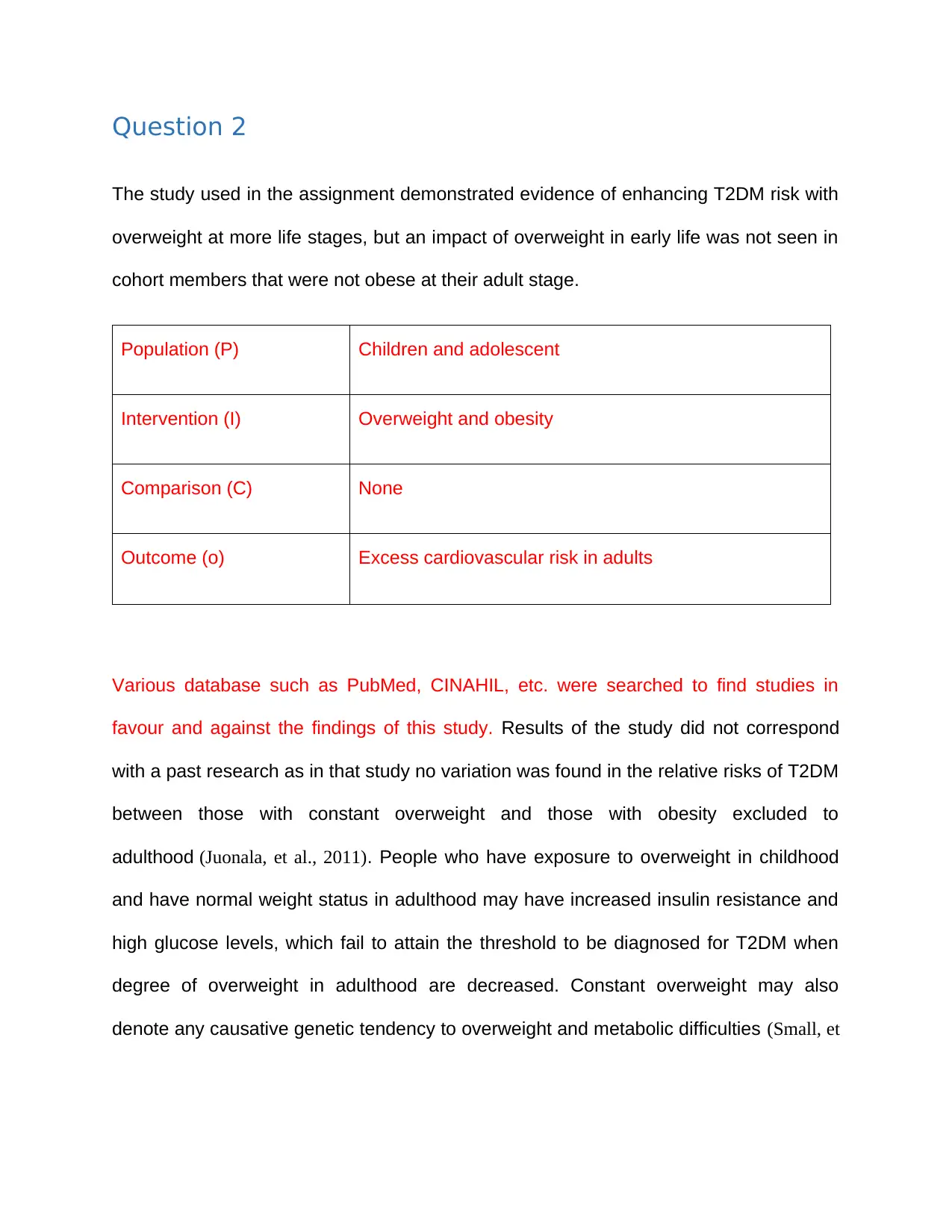
Question 2
The study used in the assignment demonstrated evidence of enhancing T2DM risk with
overweight at more life stages, but an impact of overweight in early life was not seen in
cohort members that were not obese at their adult stage.
Population (P) Children and adolescent
Intervention (I) Overweight and obesity
Comparison (C) None
Outcome (o) Excess cardiovascular risk in adults
Various database such as PubMed, CINAHIL, etc. were searched to find studies in
favour and against the findings of this study. Results of the study did not correspond
with a past research as in that study no variation was found in the relative risks of T2DM
between those with constant overweight and those with obesity excluded to
adulthood (Juonala, et al., 2011). People who have exposure to overweight in childhood
and have normal weight status in adulthood may have increased insulin resistance and
high glucose levels, which fail to attain the threshold to be diagnosed for T2DM when
degree of overweight in adulthood are decreased. Constant overweight may also
denote any causative genetic tendency to overweight and metabolic difficulties (Small, et
The study used in the assignment demonstrated evidence of enhancing T2DM risk with
overweight at more life stages, but an impact of overweight in early life was not seen in
cohort members that were not obese at their adult stage.
Population (P) Children and adolescent
Intervention (I) Overweight and obesity
Comparison (C) None
Outcome (o) Excess cardiovascular risk in adults
Various database such as PubMed, CINAHIL, etc. were searched to find studies in
favour and against the findings of this study. Results of the study did not correspond
with a past research as in that study no variation was found in the relative risks of T2DM
between those with constant overweight and those with obesity excluded to
adulthood (Juonala, et al., 2011). People who have exposure to overweight in childhood
and have normal weight status in adulthood may have increased insulin resistance and
high glucose levels, which fail to attain the threshold to be diagnosed for T2DM when
degree of overweight in adulthood are decreased. Constant overweight may also
denote any causative genetic tendency to overweight and metabolic difficulties (Small, et
Paraphrase This Document
Need a fresh take? Get an instant paraphrase of this document with our AI Paraphraser
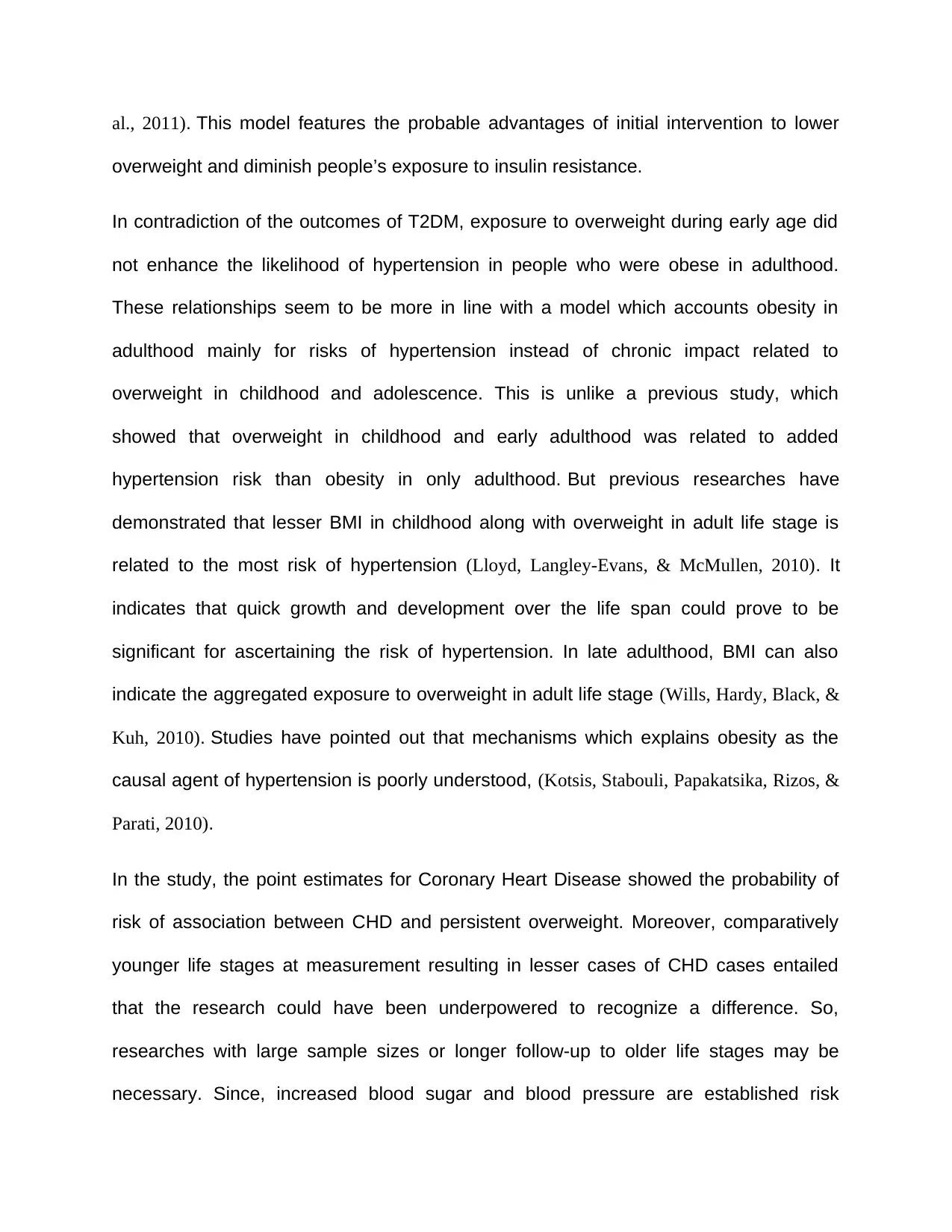
al., 2011). This model features the probable advantages of initial intervention to lower
overweight and diminish people’s exposure to insulin resistance.
In contradiction of the outcomes of T2DM, exposure to overweight during early age did
not enhance the likelihood of hypertension in people who were obese in adulthood.
These relationships seem to be more in line with a model which accounts obesity in
adulthood mainly for risks of hypertension instead of chronic impact related to
overweight in childhood and adolescence. This is unlike a previous study, which
showed that overweight in childhood and early adulthood was related to added
hypertension risk than obesity in only adulthood. But previous researches have
demonstrated that lesser BMI in childhood along with overweight in adult life stage is
related to the most risk of hypertension (Lloyd, Langley-Evans, & McMullen, 2010). It
indicates that quick growth and development over the life span could prove to be
significant for ascertaining the risk of hypertension. In late adulthood, BMI can also
indicate the aggregated exposure to overweight in adult life stage (Wills, Hardy, Black, &
Kuh, 2010). Studies have pointed out that mechanisms which explains obesity as the
causal agent of hypertension is poorly understood, (Kotsis, Stabouli, Papakatsika, Rizos, &
Parati, 2010).
In the study, the point estimates for Coronary Heart Disease showed the probability of
risk of association between CHD and persistent overweight. Moreover, comparatively
younger life stages at measurement resulting in lesser cases of CHD cases entailed
that the research could have been underpowered to recognize a difference. So,
researches with large sample sizes or longer follow-up to older life stages may be
necessary. Since, increased blood sugar and blood pressure are established risk
overweight and diminish people’s exposure to insulin resistance.
In contradiction of the outcomes of T2DM, exposure to overweight during early age did
not enhance the likelihood of hypertension in people who were obese in adulthood.
These relationships seem to be more in line with a model which accounts obesity in
adulthood mainly for risks of hypertension instead of chronic impact related to
overweight in childhood and adolescence. This is unlike a previous study, which
showed that overweight in childhood and early adulthood was related to added
hypertension risk than obesity in only adulthood. But previous researches have
demonstrated that lesser BMI in childhood along with overweight in adult life stage is
related to the most risk of hypertension (Lloyd, Langley-Evans, & McMullen, 2010). It
indicates that quick growth and development over the life span could prove to be
significant for ascertaining the risk of hypertension. In late adulthood, BMI can also
indicate the aggregated exposure to overweight in adult life stage (Wills, Hardy, Black, &
Kuh, 2010). Studies have pointed out that mechanisms which explains obesity as the
causal agent of hypertension is poorly understood, (Kotsis, Stabouli, Papakatsika, Rizos, &
Parati, 2010).
In the study, the point estimates for Coronary Heart Disease showed the probability of
risk of association between CHD and persistent overweight. Moreover, comparatively
younger life stages at measurement resulting in lesser cases of CHD cases entailed
that the research could have been underpowered to recognize a difference. So,
researches with large sample sizes or longer follow-up to older life stages may be
necessary. Since, increased blood sugar and blood pressure are established risk
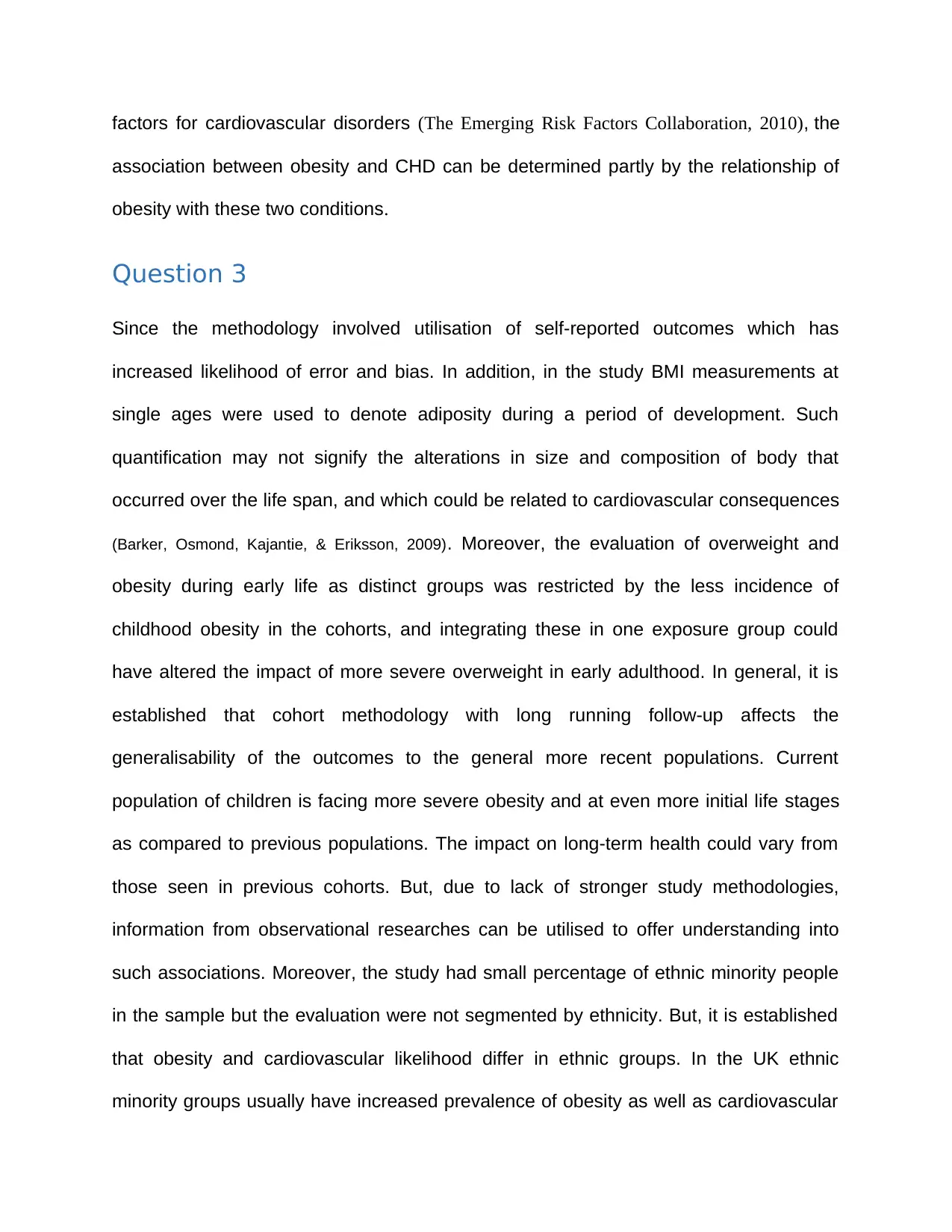
factors for cardiovascular disorders (The Emerging Risk Factors Collaboration, 2010), the
association between obesity and CHD can be determined partly by the relationship of
obesity with these two conditions.
Question 3
Since the methodology involved utilisation of self-reported outcomes which has
increased likelihood of error and bias. In addition, in the study BMI measurements at
single ages were used to denote adiposity during a period of development. Such
quantification may not signify the alterations in size and composition of body that
occurred over the life span, and which could be related to cardiovascular consequences
(Barker, Osmond, Kajantie, & Eriksson, 2009). Moreover, the evaluation of overweight and
obesity during early life as distinct groups was restricted by the less incidence of
childhood obesity in the cohorts, and integrating these in one exposure group could
have altered the impact of more severe overweight in early adulthood. In general, it is
established that cohort methodology with long running follow-up affects the
generalisability of the outcomes to the general more recent populations. Current
population of children is facing more severe obesity and at even more initial life stages
as compared to previous populations. The impact on long-term health could vary from
those seen in previous cohorts. But, due to lack of stronger study methodologies,
information from observational researches can be utilised to offer understanding into
such associations. Moreover, the study had small percentage of ethnic minority people
in the sample but the evaluation were not segmented by ethnicity. But, it is established
that obesity and cardiovascular likelihood differ in ethnic groups. In the UK ethnic
minority groups usually have increased prevalence of obesity as well as cardiovascular
association between obesity and CHD can be determined partly by the relationship of
obesity with these two conditions.
Question 3
Since the methodology involved utilisation of self-reported outcomes which has
increased likelihood of error and bias. In addition, in the study BMI measurements at
single ages were used to denote adiposity during a period of development. Such
quantification may not signify the alterations in size and composition of body that
occurred over the life span, and which could be related to cardiovascular consequences
(Barker, Osmond, Kajantie, & Eriksson, 2009). Moreover, the evaluation of overweight and
obesity during early life as distinct groups was restricted by the less incidence of
childhood obesity in the cohorts, and integrating these in one exposure group could
have altered the impact of more severe overweight in early adulthood. In general, it is
established that cohort methodology with long running follow-up affects the
generalisability of the outcomes to the general more recent populations. Current
population of children is facing more severe obesity and at even more initial life stages
as compared to previous populations. The impact on long-term health could vary from
those seen in previous cohorts. But, due to lack of stronger study methodologies,
information from observational researches can be utilised to offer understanding into
such associations. Moreover, the study had small percentage of ethnic minority people
in the sample but the evaluation were not segmented by ethnicity. But, it is established
that obesity and cardiovascular likelihood differ in ethnic groups. In the UK ethnic
minority groups usually have increased prevalence of obesity as well as cardiovascular
⊘ This is a preview!⊘
Do you want full access?
Subscribe today to unlock all pages.

Trusted by 1+ million students worldwide
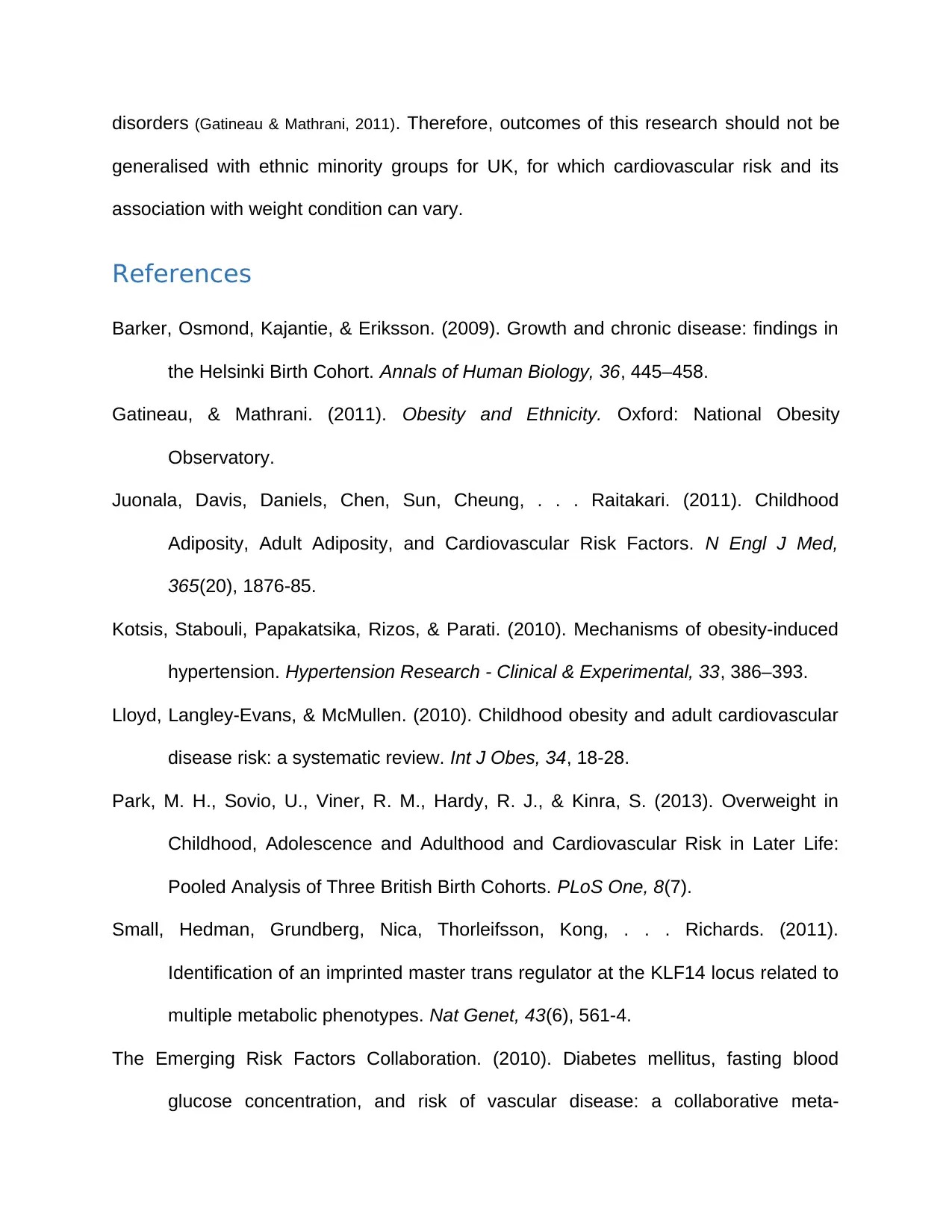
disorders (Gatineau & Mathrani, 2011). Therefore, outcomes of this research should not be
generalised with ethnic minority groups for UK, for which cardiovascular risk and its
association with weight condition can vary.
References
Barker, Osmond, Kajantie, & Eriksson. (2009). Growth and chronic disease: findings in
the Helsinki Birth Cohort. Annals of Human Biology, 36, 445–458.
Gatineau, & Mathrani. (2011). Obesity and Ethnicity. Oxford: National Obesity
Observatory.
Juonala, Davis, Daniels, Chen, Sun, Cheung, . . . Raitakari. (2011). Childhood
Adiposity, Adult Adiposity, and Cardiovascular Risk Factors. N Engl J Med,
365(20), 1876-85.
Kotsis, Stabouli, Papakatsika, Rizos, & Parati. (2010). Mechanisms of obesity-induced
hypertension. Hypertension Research - Clinical & Experimental, 33, 386–393.
Lloyd, Langley-Evans, & McMullen. (2010). Childhood obesity and adult cardiovascular
disease risk: a systematic review. Int J Obes, 34, 18-28.
Park, M. H., Sovio, U., Viner, R. M., Hardy, R. J., & Kinra, S. (2013). Overweight in
Childhood, Adolescence and Adulthood and Cardiovascular Risk in Later Life:
Pooled Analysis of Three British Birth Cohorts. PLoS One, 8(7).
Small, Hedman, Grundberg, Nica, Thorleifsson, Kong, . . . Richards. (2011).
Identification of an imprinted master trans regulator at the KLF14 locus related to
multiple metabolic phenotypes. Nat Genet, 43(6), 561-4.
The Emerging Risk Factors Collaboration. (2010). Diabetes mellitus, fasting blood
glucose concentration, and risk of vascular disease: a collaborative meta-
generalised with ethnic minority groups for UK, for which cardiovascular risk and its
association with weight condition can vary.
References
Barker, Osmond, Kajantie, & Eriksson. (2009). Growth and chronic disease: findings in
the Helsinki Birth Cohort. Annals of Human Biology, 36, 445–458.
Gatineau, & Mathrani. (2011). Obesity and Ethnicity. Oxford: National Obesity
Observatory.
Juonala, Davis, Daniels, Chen, Sun, Cheung, . . . Raitakari. (2011). Childhood
Adiposity, Adult Adiposity, and Cardiovascular Risk Factors. N Engl J Med,
365(20), 1876-85.
Kotsis, Stabouli, Papakatsika, Rizos, & Parati. (2010). Mechanisms of obesity-induced
hypertension. Hypertension Research - Clinical & Experimental, 33, 386–393.
Lloyd, Langley-Evans, & McMullen. (2010). Childhood obesity and adult cardiovascular
disease risk: a systematic review. Int J Obes, 34, 18-28.
Park, M. H., Sovio, U., Viner, R. M., Hardy, R. J., & Kinra, S. (2013). Overweight in
Childhood, Adolescence and Adulthood and Cardiovascular Risk in Later Life:
Pooled Analysis of Three British Birth Cohorts. PLoS One, 8(7).
Small, Hedman, Grundberg, Nica, Thorleifsson, Kong, . . . Richards. (2011).
Identification of an imprinted master trans regulator at the KLF14 locus related to
multiple metabolic phenotypes. Nat Genet, 43(6), 561-4.
The Emerging Risk Factors Collaboration. (2010). Diabetes mellitus, fasting blood
glucose concentration, and risk of vascular disease: a collaborative meta-
Paraphrase This Document
Need a fresh take? Get an instant paraphrase of this document with our AI Paraphraser

analysis of 102 prospective studie. The Lancet, 375, 2215–2222.
Wills, Hardy, Black, & Kuh. (2010). Trajectories of overweight and body mass index in
adulthood and blood pressure at age 53: the 1946 British birth cohort study.
Journal of Hypertension, 28, 679–686.
Wills, Hardy, Black, & Kuh. (2010). Trajectories of overweight and body mass index in
adulthood and blood pressure at age 53: the 1946 British birth cohort study.
Journal of Hypertension, 28, 679–686.
1 out of 8
Related Documents
Your All-in-One AI-Powered Toolkit for Academic Success.
+13062052269
info@desklib.com
Available 24*7 on WhatsApp / Email
![[object Object]](/_next/static/media/star-bottom.7253800d.svg)
Unlock your academic potential
Copyright © 2020–2025 A2Z Services. All Rights Reserved. Developed and managed by ZUCOL.





